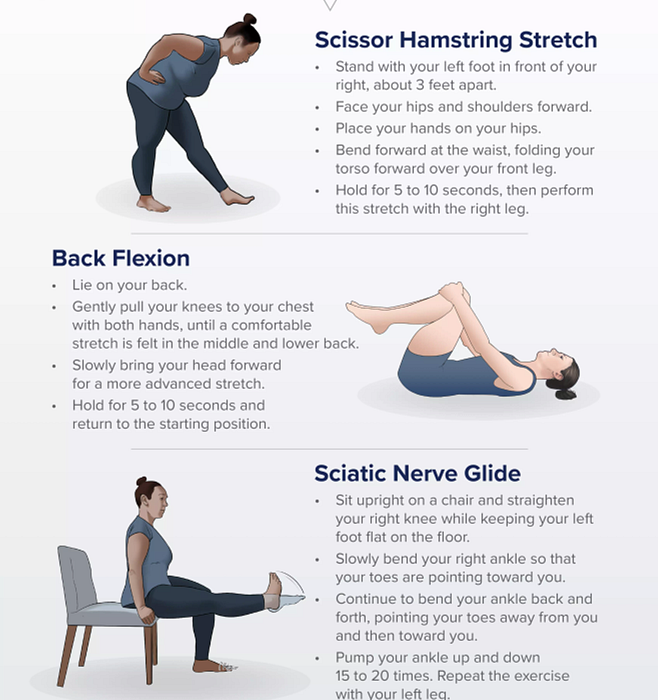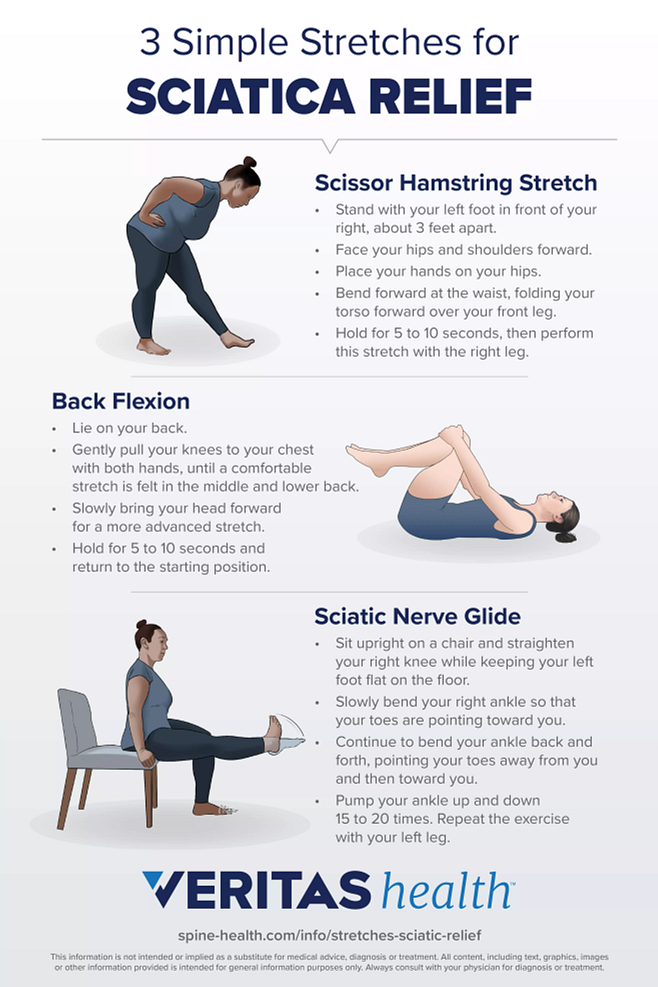Dealing with the excruciating pain of sciatica can be a real pain in the backside, literally! But fear not, my friend, because I’m here to share some fantastic relief options that will have you feeling like you’re walking on cloud nine. So, what are some pain relief options for sciatica? Let’s dive in and explore the wonderful world of remedies that can help ease your discomfort and get you back on your feet.
When it comes to soothing sciatica, there are several approaches you can take. One of the most common and effective methods is good ol’ fashioned stretching. Stretching exercises can help alleviate the pressure on the sciatic nerve and provide much-needed relief. Another option is the use of hot and cold therapy. Applying a heating pad or taking a warm bath can help relax the muscles and reduce inflammation, while using an ice pack can numb the area and reduce swelling. Additionally, over-the-counter pain medications, such as ibuprofen or acetaminophen, can provide temporary relief from the pain. And for those seeking a more holistic approach, acupuncture and chiropractic adjustments have been known to work wonders in relieving sciatic pain. So, whether you prefer stretching, heat and cold therapy, medication, or alternative treatments, there are plenty of options available to help you bid farewell to sciatica and hello to a pain-free life.
What are some pain relief options for sciatica?
Sciatica is a condition characterized by pain that radiates along the sciatic nerve, which runs from the lower back down the back of each leg. It can cause discomfort, numbness, tingling, and weakness in the affected leg. If you’re experiencing sciatica, you may be wondering what pain relief options are available to help alleviate your symptoms. In this article, we will explore some effective methods to manage sciatica pain and promote healing.
1. Physical Therapy and Exercise
Physical therapy and exercise can be highly beneficial for individuals suffering from sciatica. A licensed physical therapist can design a personalized treatment plan that includes targeted exercises and stretches to relieve pain, improve flexibility, and strengthen the muscles supporting the spine. These exercises may include gentle stretches, core-strengthening exercises, and low-impact aerobic activities like swimming or walking. Regular physical therapy sessions can help reduce pain and prevent future sciatica flare-ups.
In addition to physical therapy, maintaining an active lifestyle and incorporating regular exercise into your routine can also provide long-term pain relief. Engaging in activities that promote core strength and flexibility, such as yoga or Pilates, can help alleviate sciatica symptoms by improving posture and reducing pressure on the sciatic nerve.
Benefits of Physical Therapy and Exercise for Sciatica
Physical therapy and exercise offer several benefits for individuals with sciatica. Firstly, they can help improve posture and spinal alignment, reducing pressure on the sciatic nerve. Secondly, regular exercise helps release endorphins, which are natural pain-relieving chemicals in the body. This can provide immediate relief from sciatic pain. Lastly, physical therapy and exercise can strengthen the muscles supporting the spine, reducing the risk of future sciatica episodes.
It’s important to consult with a healthcare professional or physical therapist before starting any exercise program to ensure it is safe and appropriate for your specific condition and needs. They can guide you through proper techniques and recommend exercises that target the underlying causes of your sciatica.
2. Medications
Medications can play a crucial role in managing sciatica pain. Nonsteroidal anti-inflammatory drugs (NSAIDs), such as ibuprofen or naproxen, can help reduce inflammation and alleviate pain. These over-the-counter medications can be effective for mild to moderate sciatica symptoms. However, it’s important to follow the recommended dosage and consult with a healthcare professional if you have any underlying health conditions or are taking other medications.
If over-the-counter medications are not providing sufficient pain relief, your doctor may prescribe stronger medications, such as muscle relaxants or opioids, for short-term use. These medications should be used under the guidance of a healthcare professional due to potential side effects and risks associated with long-term use.
Types of Medications for Sciatica
There are several types of medications that may be used to manage sciatica pain. NSAIDs, as mentioned earlier, are commonly used for their anti-inflammatory and pain-relieving properties. Muscle relaxants can help relieve muscle spasms and reduce associated pain. In more severe cases, corticosteroid injections may be administered directly into the affected area to reduce inflammation and provide temporary relief. However, it’s important to note that these injections are typically used for short-term pain relief and are not a long-term solution.
It’s always essential to consult with a healthcare professional before starting any medication regimen to ensure it is suitable for your specific condition and to minimize the risk of adverse effects.
3. Heat and Cold Therapy
Heat and cold therapy can be effective in providing temporary relief from sciatica pain. Applying a heating pad or hot pack to the affected area can help relax muscles, improve blood circulation, and reduce pain. Heat therapy is particularly useful for alleviating muscle spasms and promoting relaxation.
On the other hand, cold therapy, such as applying an ice pack or cold compress to the affected area, can help reduce inflammation and numb the area, temporarily relieving pain. Cold therapy is especially beneficial during the initial stages of sciatica when there is significant inflammation.
How to Use Heat and Cold Therapy for Sciatica
To use heat therapy, apply a heating pad or hot pack to the affected area for 15-20 minutes at a time, several times a day. Be sure to use a towel or cloth as a barrier between the heat source and your skin to prevent burns. Cold therapy can be applied using an ice pack or cold compress for 10-15 minutes at a time, several times a day. Remember to wrap the ice pack in a thin cloth to protect your skin from frostbite.
It’s important to note that heat and cold therapy should be used with caution, and it’s best to consult with a healthcare professional to determine the most suitable method and duration of application for your specific condition.
4. Alternative Therapies
In addition to conventional treatments, alternative therapies can also provide relief for individuals with sciatica. These therapies focus on holistic approaches to pain management and aim to address the underlying causes of sciatica, rather than just the symptoms.
Some popular alternative therapies for sciatica include chiropractic care, acupuncture, and massage therapy. Chiropractic adjustments can help realign the spine, reducing pressure on the sciatic nerve. Acupuncture, an ancient Chinese practice that involves inserting thin needles into specific points on the body, can help stimulate the release of endorphins and promote pain relief. Massage therapy can help relax tense muscles, improve blood circulation, and reduce pain and inflammation.
Benefits of Alternative Therapies for Sciatica
Alternative therapies offer a range of benefits for individuals with sciatica. They provide a non-invasive and drug-free approach to pain management, minimizing the risk of side effects associated with medications. These therapies also focus on addressing the root causes of sciatica and promoting overall well-being, rather than just symptom relief. Additionally, alternative therapies can be used as complementary treatments alongside conventional methods to enhance pain relief and improve overall outcomes.
It’s important to consult with qualified professionals when seeking alternative therapies for sciatica. They can assess your condition and recommend appropriate treatments based on your individual needs and preferences.
5. Lifestyle Modifications
Making certain lifestyle modifications can also help manage sciatica pain and prevent future episodes. Maintaining a healthy weight is crucial, as excess weight can put additional stress on the spine and exacerbate sciatica symptoms. Engaging in regular exercise and following a balanced diet can help achieve and maintain a healthy weight.
Improving posture is another important aspect of managing sciatica. Proper posture helps distribute weight evenly, reducing pressure on the spine and nerves. Avoiding prolonged sitting or standing and using ergonomic furniture and accessories can help support good posture.
Additionally, practicing good body mechanics, such as lifting heavy objects with proper form and avoiding excessive twisting or bending, can help prevent injury and minimize the risk of sciatica flare-ups.
Tips for Lifestyle Modifications
To maintain a healthy weight, incorporate a combination of cardiovascular exercises, strength training, and a balanced diet. Engaging in activities that you enjoy will make it easier to stick to a regular exercise routine. When sitting or standing for extended periods, take breaks to stretch and move around. Consider using a lumbar support cushion or an adjustable standing desk to maintain proper posture and reduce strain on the back.
Implementing these lifestyle modifications can significantly contribute to long-term pain relief and improve overall spinal health.
Conclusion
In conclusion, there are various pain relief options available for individuals suffering from sciatica. Physical therapy and exercise, medications, heat and cold therapy, alternative therapies, and lifestyle modifications can all play a significant role in managing sciatica pain and promoting healing. It’s important to consult with a healthcare professional to determine the most appropriate treatment plan for your specific condition. By incorporating these strategies into your daily routine, you can find relief from sciatica and improve your quality of life.
Key Takeaways – Pain Relief Options for Sciatica
- Stay active and incorporate gentle exercises into your routine.
- Apply hot or cold packs to the affected area for pain relief.
- Take over-the-counter pain medications like ibuprofen or acetaminophen.
- Try alternative treatments such as acupuncture or chiropractic care.
- Consider physical therapy to strengthen the muscles and improve flexibility.
Frequently Asked Questions
What are the common causes of sciatica?
Sciatica is typically caused by a compressed or irritated sciatic nerve. The most common causes include a herniated disc, spinal stenosis, degenerative disc disease, and muscle spasms. These conditions can put pressure on the nerve, leading to pain, numbness, and tingling sensations that radiate down the leg.
Can over-the-counter pain medications help with sciatica?
Over-the-counter pain medications such as nonsteroidal anti-inflammatory drugs (NSAIDs) can provide temporary relief from sciatica pain. Medications like ibuprofen or naproxen sodium can help reduce inflammation and alleviate discomfort. However, it is important to consult with a healthcare professional before taking any medication to ensure it is safe and suitable for your specific condition.
Are there any home remedies that can help relieve sciatica pain?
While home remedies may not provide a complete cure for sciatica, they can help alleviate symptoms and provide temporary relief. Applying hot or cold packs to the affected area can help reduce inflammation and soothe the pain. Gentle stretching exercises, such as lying on your back and bringing one knee to your chest, can also help relieve pressure on the sciatic nerve.
What are some non-surgical treatment options for sciatica?
Non-surgical treatment options for sciatica include physical therapy, chiropractic care, and acupuncture. Physical therapy can help strengthen the muscles around the sciatic nerve, improve flexibility, and reduce pain. Chiropractic adjustments can help realign the spine and reduce pressure on the nerve. Acupuncture, a traditional Chinese medicine practice, involves the insertion of thin needles into specific points of the body to relieve pain and promote healing.
When is surgery recommended for sciatica?
Surgery for sciatica is typically considered when non-surgical treatments have failed to provide relief, and the pain and symptoms significantly impact daily activities. The most common surgical option is a discectomy, which involves removing the herniated disc that is compressing the sciatic nerve. Other surgical procedures may be recommended depending on the underlying cause of the sciatica. It is important to consult with a healthcare professional to determine the best course of treatment for your specific condition.
The ONE Exercise You MUST Do For Sciatica Pain Relief (WORKS FAST!)
Final Thoughts:
When it comes to finding relief from the debilitating pain of sciatica, there are several options that can help alleviate discomfort and improve your quality of life. From conservative treatments to more invasive procedures, there is a range of choices available to suit different needs and preferences. So, let’s take a moment to recap some of the key pain relief options for sciatica.
One of the most effective and commonly recommended approaches is physical therapy. Engaging in targeted exercises and stretches can help strengthen the muscles around the affected area, reduce inflammation, and relieve pressure on the sciatic nerve. Additionally, over-the-counter pain medications, such as nonsteroidal anti-inflammatory drugs (NSAIDs), can provide temporary relief by reducing pain and inflammation. However, it’s important to consult with a healthcare professional before starting any medication regimen.
In more severe cases, your healthcare provider may recommend epidural steroid injections. These injections deliver powerful anti-inflammatory medication directly to the affected nerve root, providing immediate pain relief and reducing inflammation. Another option for chronic or severe cases is surgery. Surgical interventions, such as a discectomy or laminectomy, aim to alleviate pressure on the sciatic nerve and address the underlying cause of the pain. However, surgery is typically considered a last resort when other conservative treatments have been unsuccessful.
Remember, everyone’s experience with sciatica is unique, and what works for one person may not work for another. It’s crucial to consult with a healthcare professional to determine the most appropriate pain relief options for your specific situation. By taking a proactive approach and exploring the various treatments available, you can find relief and get back to enjoying life without the burden of sciatic pain.




